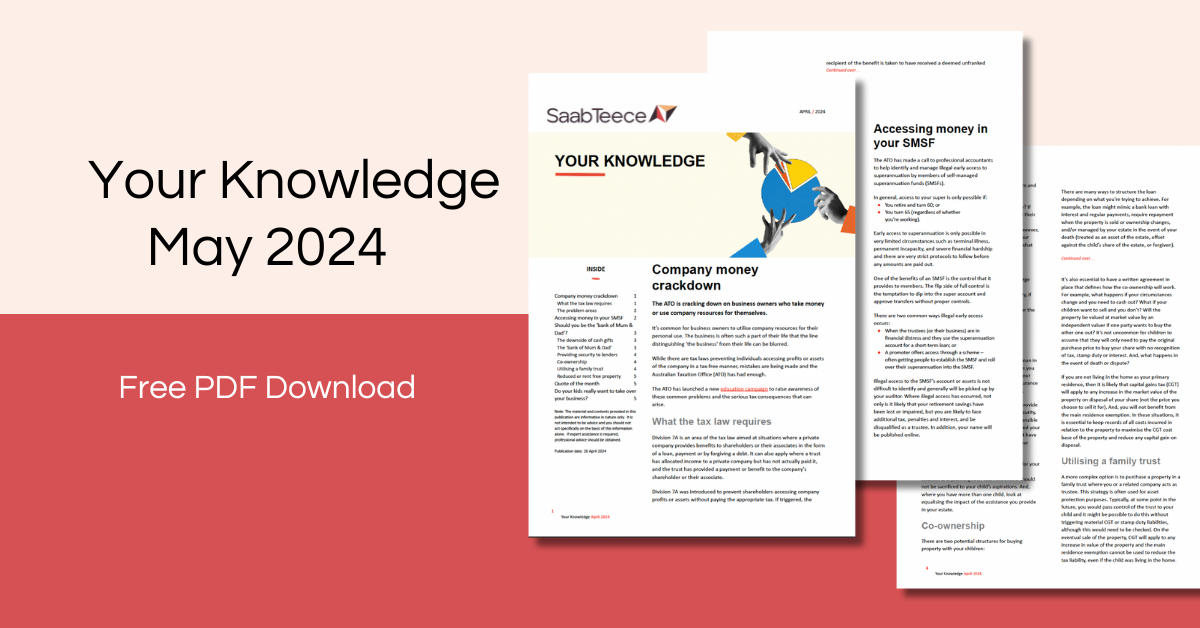How can life insurance protect you and your family?
Did you know that most superannuation funds provide default life, permanent disability (TPD) and income protection to its members? Unfortunately, many people give far more consideration to their car insurance than they do their life insurances.
The advisers from ST Wealth have provided a detailed summary of the different types of life insurances and how they protect you and your family. They have also detailed what insurances can be paid from your superannuation fund and how this can be structured.
If any of the scenarios are of interest to you or you haven’t reviewed your life insurances recently (or ever) please contact ST Wealth to start a conversation.
Types of Life Insurance?
Life Insurance can help protect you and your loved ones financially if something unexpected happens.
- Life Cover - pays a lump sum when you die.
- Total and Permanent Disability Cover (TPD) - pays a lump sum to help you with rehabilitation and living costs if you are unable to work again.
- Trauma Insurance/Critical Illness Cover - covers you if you’re diagnosed with a major traumatic illness. Eg. cancer, heart attack or stroke.
- Income Protection Cover - pays some of your income if you can’t work due to illness or injury.
- Buy/Sell or Key Man Personal Insurance - ensures a smooth transition of business ownership in the above listed events (and possibly more).
In simple terms, life insurances provide a level of financial security to you and your family in certain events.
How can life insurance protect me and my family?
Your life insurance should tie in as a ‘risk reduction’ component of your overall financial plan.
Think about it like this… you probably have a car insurance policy just in case something goes wrong.
Exactly the same concept, except you are far more valuable than your car.
You can use the different policies available to give you and your family a desired outcome in certain unexpected scenarios.
Scenarios where life insurance may be appropriate
There are a few things to consider when looking to put in place life insurance.
Ideally, if you know what you want as an outcome for your family in each of the scenarios, it makes it easier to provide a dollar figure of cover to achieve the desired outcome.
Please consider each of the scenarios below and what outcome you would like for your family:
In the event you were to pass away:
- Funeral expenses.
- Clearing debts (eg. own home paid off for the family, clearing off investment debt means an income stream for your family).
- Income (eg. $100k per annum for 10 years so your family doesn’t have to change living standards).
- Expenses (eg. childcare or private schooling fees to cover each child until age 18).
In the event you were totally and permanently disabled (you couldn’t work again):
- All of the above considerations.
- Medical expenses (eg. one off medical expense costs covered).
- Carer costs (eg. an amount left to pay for a carer or for a partner/family member to care for you so it is not a financial burden).
- The gap not covered by Income Protection (eg. if you needed your full income to maintain lifestyle in this event).
In the event you couldn't work for an extended period of time due to injury or illness:
- Have your income replaced (typical maximum amount is 75% plus super contributions).
- Have this cover start paying from the time you are unable to work and after the policy “waiting period” (eg 14 days, 30 days, 6 months, 1 year) up to the time you want it to keep paying your income per the policy “benefit period” (eg.1 year, 2 years, 5 years, up to the age of 70).
- Simple example of what this would look like for protecting a $120k income without super contributions would be $120k x 75% = $90k per annum. It is paid on a monthly basis so you would still have $7,500 per month being paid into your bank account to meet living expenses and debts.
In the event you suffered a serious or critical medical trauma event:
- Medical costs (eg. to see the best doctors and cover treatment).
- Partner/Family subsidy - during these times loved ones would typically take time off work to care for you which is not covered (eg. partner earns $100,000 per year. Taking 6 months off to be with you, could add in $50,000 onto the policy).
- Child trauma (eg. lump sum if your child has a trauma event, for example if your child was diagnosed with cancer).
What premiums can be paid by your superannuation fund?
Keeping it simple, the following policies can be paid by your superannuation fund:
- Life (death) insurance,
- Total and Permanent Disability,
- Income Protection.
The added benefit to having your superannuation fund pay for these premiums is it will collect the tax deductions associated with these premiums.
Trauma/Critical illness cover needs to be paid for personally. This is due to the fact that if you have a traumatic event that does not meet a 'condition of release' from superannuation then the essential funds you need would be trapped inside superannuation.
How to have your superannuation fund pay for the premiums?
Where possible, you can have your policy set up with superannuation fund ownership and have the premiums paid for with your superfund money.
If you have an existing retail insurance fund, some providers will allow you to change the ownership of the policy. Please be careful that there are no risks to you by doing this eg. extending a waiting period.
Did you know these 3 things about personal insurance?
- You can pay for the premiums of Life Cover, TPD Cover and Income Protection Cover through your Superannuation fund.
Without realising it, you might already have these provided to you automatically inside your superannuation fund. - Personal Insurance (policies) are a contract. Normally between the Life Insurance company, the person insured and the person/entity paying the premiums. If you have taken out a retail insurance product and have had to go through ‘medical underwriting’; companies typically can’t change your contract.
- Not all personal insurance policies are equal. Different products and policies have different contract terms and will without doubt have different costs. Age, occupation and amount insured will all have a major impact on the premium price.
Make sure you know what your policy covers you for and when you are eligible to claim on it.
If any of the above scenarios are of interest to you or you haven’t reviewed your life insurances recently (or ever) please contact ST Wealth to start a conversation.
Article by
ST Wealth shared to clients of SaabTeece.
Recent Posts

SaabTeece
Liability limited by a scheme approved under Professional Standards Legislation.
Shop 2, 17-25 William St, Earlwood, NSW 2206 Australia








